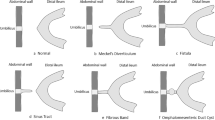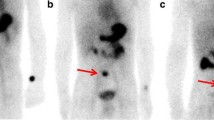Abstract
Background
Technetium 99mTc-pertechnetate is the most common and accurate noninvasive method of preoperative investigation for Meckel diverticulum. Despite introducing various methods to increase the sensitivity of the study, there are many case reports of false-negative Meckel scans. A repeat scan is sometimes requested in patients with a high suspicion for Meckel diverticulum and negative or equivocal first Meckel scan.
Objectives
The purpose of this retrospective study is to evaluate the value of repeat scintigraphy for these patients.
Materials and methods
Seven hundred fifty-three Meckel scans were recorded retrospectively. In 33 cases (22 male and 11 female; mean age: 6.8 years), the Meckel scintigraphy was repeated either due to a high clinical suspicion of Meckel diverticulum and a negative study (n = 21) or due to equivocal findings in the first scan (n = 12). The study was interpreted as positive if an abnormal focal activity was identified in the abdomen and pelvis during the procedure. The results were correlated with pathology and clinical symptoms.
Results
Seven out of 12 (58%) equivocal studies were positive on the second study. Six of them were proven to be positive at operation (confirmed by pathology) while one of them was negative on laparoscopy. From 21 negative first scans with a high suspicion for Meckel diverticulum, three (14%) were positive on the second study. All three were proven to be Meckel diverticulum on pathology.
Conclusion
Repeat Meckel scans in patients with equivocal findings on the first study or a negative result with a high clinical suspicion for a Meckel diverticulum are useful especially in cases in which the first study had been done without appropriate preparation.




Similar content being viewed by others
References
Satya R, O’Malley JP (2005) Case 86: Meckel diverticulum with massive bleeding. Radiology 236:836–840
Park JJ, Wolff BG, Tollefson MK et al (2005) Meckel diverticulum: the Mayo Clinic experience with 1476 patients (1950–2002). Ann Surg 241:529–533
Matsagas MI, Fatouros M, Koulouras B et al (1995) Incidence, complications, and management of Meckel’s diverticulum. Arch Surg 130:143–146
Sfakianakis GN, Conway JJ (1981) Detection of ectopic gastric mucosa in Meckel’s diverticulum and in other aberrations by scintigraphy: ii. indications and methods–a 10-year experience. J Nucl Med 22:732–738
Bemelman WA, Hugenholtz E, Heij HA et al (1995) Meckel’s diverticulum in Amsterdam: experience in 136 patients. World J Surg 19:734–736
Elsayes KM, Menias CO, Harvin HJ et al (2007) Imaging manifestations of Meckel’s diverticulum. AJR Am J Roentgenol 189:81–88
Wilton G, Froelich JW (1982) The “false-negative” Meckel’s scan. Clin Nucl Med 7:441–443
Ariga M, Suga K, Matsunaga N et al (2001) Failure to detect a huge Meckel’s diverticulum with abundant ectopic gastric mucosa on gastric mucosal scintigraphy with Tc-99 m pertechnetate. Clin Nucl Med 26:470–471
Sharma RK, Jain VK (2008) Emergency surgery for Meckel’s diverticulum. World J Emerg Surg 3:27
Tulchinsky M (2006) Meckel’s scan: pitfall in patients with active small bowel bleeding. Clin Nucl Med 31:814–816
Gelfand MJ, Parisi MT, Treves ST et al (2011) Pediatric radiopharmaceutical administered doses: 2010 North American consensus guidelines. J Nucl Med 52:318–322
Schwartz MJ, Lewis JH (1984) Meckel’s diverticulum: pitfalls in scintigraphic detection in the adult. Am J Gastroenterol 79:611–618
Petrokubi RJ, Baum S, Rohrer GV (1978) Cimetidine administration resulting in improved pertechnetate imaging of Meckel’s diverticulum. Clin Nucl Med 3:385–388
Singh PR, Russell CD, Dubovsky EV et al (1978) Technique of scanning for Meckel’s diverticulum. Clin Nucl Med 3:188–192
Rerksuppaphol S, Hutson JM, Oliver MR (2004) Ranitidine-enhanced 99mtechnetium pertechnetate imaging in children improves the sensitivity of identifying heterotopic gastric mucosa in Meckel’s diverticulum. Pediatr Surg Int 20:323–325
Datz FL, Taylor A Jr (1985) Utility of bladder lavage in Meckel’s scanning. Clin Nucl Med 10:804–806
Dillman JR, Wong KK, Brown RK et al (2009) Utility of SPECT/CT with Meckel’s scintigraphy. Ann Nucl Med 23:813–815
Schneider P, Duren C, Reiners C (2010) SPECT-CT image fusion could enhance Meckel scan. World J Pediatr 6:281
Papathanassiou D, Liehn JC, Meneroux B et al (2007) SPECT-CT of Meckel diverticulum. Clin Nucl Med 32:218–220
Sagar J, Kumar V, Shah DK (2006) Meckel’s diverticulum: a systematic review. J R Soc Med 99:501–505
Spottswood SE, Pfluger T, Bartold SP et al (2014) SNMMI and EANM practice guideline for meckel diverticulum scintigraphy 2.0. J Nucl Med Technol 42:163–169
Conflicts of interest
None
Author information
Authors and Affiliations
Corresponding author
Rights and permissions
About this article
Cite this article
Vali, R., Daneman, A., McQuattie, S. et al. The value of repeat scintigraphy in patients with a high clinical suspicion for Meckel diverticulum after a negative or equivocal first Meckel scan. Pediatr Radiol 45, 1506–1514 (2015). https://doi.org/10.1007/s00247-015-3340-x
Received:
Revised:
Accepted:
Published:
Issue Date:
DOI: https://doi.org/10.1007/s00247-015-3340-x




